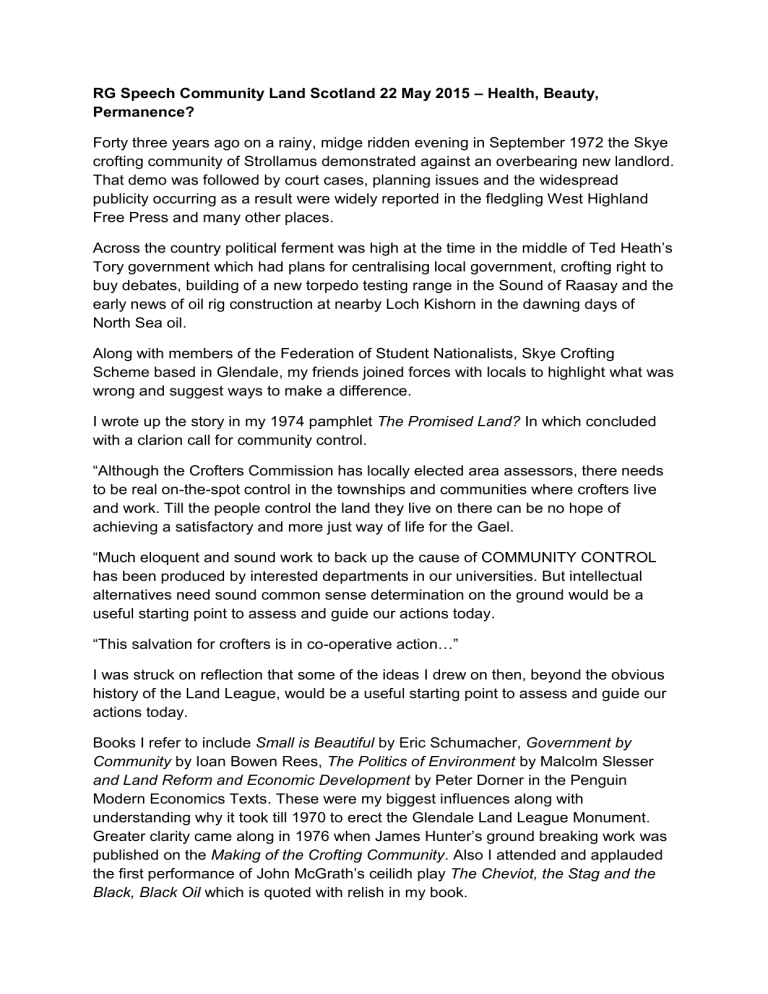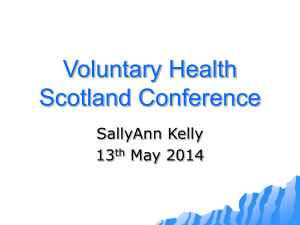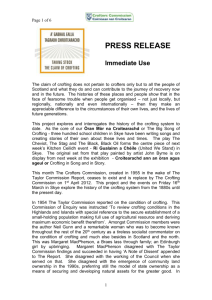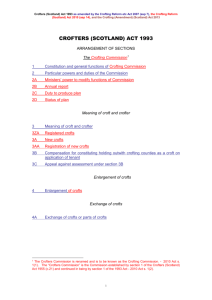RG Speech Community Land Scotland 22 May 2015 – Health

RG Speech Community Land Scotland 22 May 2015
– Health, Beauty,
Permanence?
Forty three years ago on a rainy, midge ridden evening in September 1972 the Skye crofting community of Strollamus demonstrated against an overbearing new landlord.
That demo was followed by court cases, planning issues and the widespread publicity occurring as a result were widely reported in the fledgling West Highland
Free Press and many other places.
Across the country political ferment was high at the time in the middle of Ted Heath’s
Tory government which had plans for centralising local government, crofting right to buy debates, building of a new torpedo testing range in the Sound of Raasay and the early news of oil rig construction at nearby Loch Kishorn in the dawning days of
North Sea oil.
Along with members of the Federation of Student Nationalists, Skye Crofting
Scheme based in Glendale, my friends joined forces with locals to highlight what was wrong and suggest ways to make a difference.
I wrote up the story in my 1974 pamphlet The Promised Land?
In which concluded with a clarion call for community control.
“Although the Crofters Commission has locally elected area assessors, there needs to be real on-the-spot control in the townships and communities where crofters live and work. Till the people control the land they live on there can be no hope of achieving a satisfactory and more just way of life for the Gael.
“Much eloquent and sound work to back up the cause of COMMUNITY CONTROL has been produced by interested departments in our universities. But intellectual alternatives need sound common sense determination on the ground would be a useful starting point to assess and guide our actions today.
“This salvation for crofters is in co-operative action…”
I was struck on reflection that some of the ideas I drew on then, beyond the obvious history of the Land League, would be a useful starting point to assess and guide our actions today.
Books I refer to include Small is Beautiful by Eric Schumacher, Government by
Community by Ioan Bowen Rees, The Politics of Environment by Malcolm Slesser and Land Reform and Economic Development by Peter Dorner in the Penguin
Modern Economics Texts. These were my biggest influences along with understanding why it took till 1970 to erect the Glendale Land League Monument.
Greater clarity came along in 1976 when James Hunter’s ground breaking work was published on the Making of the Crofting Community . Also I attended and applauded the first performance of
John McGrath’s ceilidh play
The Cheviot, the Stag and the
Black, Black Oil which is quoted with relish in my book.
In the long years of land reform discussions since then, the first lines in Schumacher on the proper use of land stand out.
“Among material resources, the greatest, unquestionably, is the land. Study how a society uses its land, and you can come to pretty reliable conclusions as to what its future will be.
”
There I’ve said it again!
Around the world Dorner pointed to one key to land reform:
“it is quite clear that under a system of private property in land, a small farm agriculture can absorb more labour than a large-farm agriculture.
” He went on “Agricultural production processes, as mentioned, have characteristics which invalidate many comparisons with developments in industry.
”
So why are agriculture and industry so different?
Schumacher wrote:
“on a wider view, however, the land is seen as a priceless asset which it is man’s task and happiness ‘to dress and keep’. We can say that man’s management of the land must be primarily orientated towards three goals – health, beauty and permanence. The fourth goal – the only one accepted by the experts – productivity, will then be attained almost as a byproduct.”
He explains
– “The crude materialist view [much discussed in the EEC Mansholt plan for bigger farms and more flight of redundant people to the cities] sees agriculture as essentially directed towards food production ”.
Other doubters of the primacy of productivity spoke out. One was the chemical engineer and climber Malcolm Slesser who identified the forces that damage communities saying “science is largely accurate observation coupled with common sense. The man in the street is, because of this, scientist enough to sense that something is goin g badly wrong.”
“It is dawning slowly that the use of scientific knowledge and technological skill for the conquest of poverty and disease does not of necessity mean enslavement to expansionist economics… He then argued that we have to tackle “the more complex issue resulting from the conclusion that economic growth is a doomed philosophy and a practical disaster.”
I was hooked. Then Slesser described the starting point: “with those small nations not yet committed too far along the Gadarene slope. Let them be allowed to make themselves practical examples of realignment to balanced development, in cooperation, and by humbly scientific use of their physical and mental resources.”
What did he mean by a range of resources? “We must allow for these unacademic terms ‘community spirit’, ‘national morale’ at all times, not just in the practical emergencies of war”.
Alas the story of Strollamus has sputtered on over decades so that when the John
Muir Trust was making a partnership with the Luib township of the estate ten years ago it was reported that the crofters did not know who they were sending their rents to. The recipients are probably the beneficial owners of private trusts that are still protected in law from public scrutiny. If the UK Tory Government refuses to agree that beneficial owners of private trusts should be revealed it will be another snub to the EU and the 4 th Money Laundering Directive that has to be agreed this year and it will severely curtail our efforts to find out who owns Scotland.
***
Ioan Bowen Rees had a long career of public service in Wales where he championed the governance structures in Swiss cantons such as Grisson as the ideal for decision taking. Jim Perrin picked this up in an obituary for Ioan in June
1999 praising
“his natural inclination was to view people as indisociable from place, and to insist on the centrality of their voice in determining policies that might affect it.”
I have been banging that drum to this day. That’s why I see community land as a major example of how to do the governance of localities fairly and progressively.
That’s not to say that every community should adopt a standard approach but we now have examples from the pre-devolution era of Stornoway, Assynt, Knoydart and
Eigg plus the post 2003 buy outs in Lewis[most recently in Pairc] , Skye, the Uists and Harris as well as a scattering of Lowland Scots cases to build on.
Over time both ‘community spirit’ and ‘national morale’ have played a big part in the demands for land reform. In the decades before the creation of the Scottish
Parliament it was emblematic of our powerless condition. Today by increments we are getting to grips with radical change.
During the protest years morale boosting events mounted up like the contested cairn building in 1991 to honour the unsuccessful Knoydart land raid of 1948. Many symptoms of support for land reform in Scotland came also with acclaim for the victory for free Eigg.
I recall during the Assynt crofters’ struggle in 1992 that people were watching the TV for news in pubs and family homes across Scotland. A friend of mine was a barman in Carrutherstown near Dumfries and reported punters asking – “have these crofters got that land yet?”
In 1995 the monument to the Duke of Sutherland on Ben Bhraggie received worldwide coverage due to an outline planning application to topple the duke. Then the mining millionaire Dennis Macleod who hailed from Marrel, Helmsdale suggested that it was better to put up a statue to the cleared people than to seek to tear down the Mannie.
Sutherland District planning committee inevitably threw out the outline application by
Peter Findlay and Sandy Lindsay. But Dennis proposed a Clearances museum and
trail at Helmsdale. After complications with land acquisition he scaled down the plan and the Emigrants statue was unveiled in 2007 by former first minister Alex Salmond
MSP. However Dennis endowed the fledgling history department of the UHI in
Dornoch with the rest of the funds to employ its first professor, our own Jim Hunter!
Morale boosting as such stunts were, the development of land reform ideas of the
1997 Labour Government opened the door to the community land purchase model which drew the ire of Andy Wightman. He saw this ‘fashionable idea of community’ as ‘muddled thinking’ about true land reform. His critique said these ideas are suitable in some circumstances and asserted that CRTB ‘is a proposal born out of an acceptance of the current division of land and the unregulated market.’
However in 2013 Alex Salmond the then FM announced at the CLS conference in
Sabhal M
òr Ostaig that it wants to extend the 500,000 acres already in community control to one million acres by 2020.
***
I will now explore some of the reasons why this suits the condition of Scotland today and why the impact has to consider global concerns about climate change and biodiversity as prime measures of sustainability that impacted in particular after to
2003 phase of land reform.
The ground-breaking Scottish Climate Change Act of 2009 set tough targets. These include decarbonising transport, moving away from fossil fuel uses, sequestering carbon in deep peat, reducing the emissions by agriculture and planting many more native woods and forests. Each year they are tougher to achieve. But Scotland is on a good trajectory. We are held up as an example to other parts of the UK, especially in renewable energy production and energy efficiency. But be warned if we are not successful the landscapes, fauna and flora we cherish are likely to disappear in fifty short years.
Biodiversity targets set at EU level have been missed but again Scotland is blessed with many species which are rare elsewhere. Arising from a concern for the natural heritage which is said to be under ‘deep threat’, some NGOs have taken it upon themselves to campaign for draconian restrictions on development and call for wild land to be designated in planning law and government policy.
In the meantime some charities like RSPB, JMT and SWT have become substantial land owners and claim millions of pounds from the public purse for their agrienvironment and biodiversity work.
Other groups demand more national parks and a marine park fed by the success of
Loch Lomond and the Trossachs and Cairngorm National Park models. But the philosophy has been imposed on communities just like the range of conservation designations adopted since the 1950s.
In a significant pamphlet Beyond National Parks
– Conserving the Landscape of a
Democratic Wales , Ioan Bowen Rees wrote in 1995 about conservation by command and his wish to see conservation by consent saying:
“Worst of all is the way in which communities, districts and counties are deprived of clear responsibility for the places in which they take greatest pride.”
Recently we are indebted to A Fiona D Mackenzie in Places of Possibility
– Property,
Nature and Community Land Ownership for exploring the concept of social nature – not separated but integral to all life. She quotes Bruce Braun:
“It is about disturbing the norm of nature as external to the social and opening up meanings of the term ‘nature’ and ‘the social’ to allow new ways of thinking critically and creatively about how to move forward.”
Her study of North Harris Trust has shown how a fragile community can develop remarkable means to bring nature and community into a new relationship which applies S chumacher’s mantra of promoting ‘health, beauty and permanence’.
However we should never underestimate the obstacles to achieving step changes in development in so many varied communities across Scotland.
One of these barriers noted by Fiona Mackenzie is about the relationships between public and private property and the commoditisation of nature. In conservation practices which she notes are “subject to environmental designations whose provenance lies elsewhere ” we see an enemy of social nature.
Nothing compares to ‘no trespassing’ more than the call to map core wild land areas.
SNH duly delivered a desk top exercise which was given token recognition of this in
Scotland’s Third National Planning Framework which states:
“3.23 Onshore wind will continue to make a significant contribution to diversification of energy supplies. We do not wish to see wind farm development in our National
Parks and National Scenic Areas. Scottish Planning Policy sets out the required approach to spatial frameworks which will guide new wind energy development to appropriate locations, taking into account important features including wild land
.”
Some other wild land guidance from SNH to Scottish Government in June 2014 included this advice: “Scotland’s wild land is not empty of human activities or influence, although many features such as former shielings and bothies are small in scale and their effect on the overall wilderness of an area is limited.”
That made my blood boil.
My support team noticed that when you superimpose the sites of evictions gathered in my Highland Clearances guide in its most expanded form in 2006 and placed them on the core wild land map there was an uncanny, if unscientific, overlap. Far from being wild land I call it clearances country. Reactions from the outdoor lobby
would only admit to a superficial overlap. Indeed one JMT official told me that developments in the glens were not their target in the wild land quest. Yet the small, highly vocal, band of anti-wind farms campaigners backed by the JMT want bigger and bigger buffer areas around so-called wild land areas. Is their real intention to smother all the land in aspic?
I believe Community Land Scotland must insist that there has to be another way.
After all Frank Fraser Darling explained in 1947 that we are seeing a manmade wilderness not wild land.
Even so SNH has described ‘a lack of continuity of occupation to present times’ as just a cultural link of the past to wild land areas. Surely the abnormal landscape of the shooting estates and sheep clearances of the past 200 years are the cause of that lack of continuity?
Meanwhile on the north coast around Bettyhill and Strathy the local people describe themselves as the most endangered species. This was their response to suggestions that the SSE proposal for Strathy South wind project was a danger to birds and or deep peat. I added my two pence worth saying that the breeding pairs of humans were more endangered than birds!
It’s another case of conservation by command by the RSPB and similar NGOs who feel entitled to dictate the future of wide swathes of Scotland as of right.
Ioan Bowen Rees noted that his family were brought up on the edge of the
Snowdonia National Park and were part of its fauna . That’s why I believe we need to apply the ‘social nature’ concept Fiona Mackenzie describes in a major reappraisal of all natural heritage designations. These reach over 50% of the hinterland of
Strathy compared to 14% on average across Scotland.
The need for the proper use of land was summed up by Schumacher: “In the simple question of how we treat the land, next to people our most precious resource, our entire way of life is involved, and before our policies with regard to the land will really be changed, there will have to be a great deal of philosophical, not to say religious, change.”
For Community Empowerment and Land Reform to be effective today we need that holistic outlook among all stakeholders. It is abundantly clear from my sources forty years ago and more recently that the land revolution will start to succeed with an honest embrace of social nature and community control.
The lesson for all of Scotland’s aspiring communities is to take that control and take on clear responsibility for all aspects of land management and related conservation issues. Community Land Scotland is in the vanguard of revitalising Scotland from the ground up. It is a vital part of land reform to energise communal and cooperative action
– not just for crofters but all small communities who aim for health, beauty and permanence.
Rob Gibson









